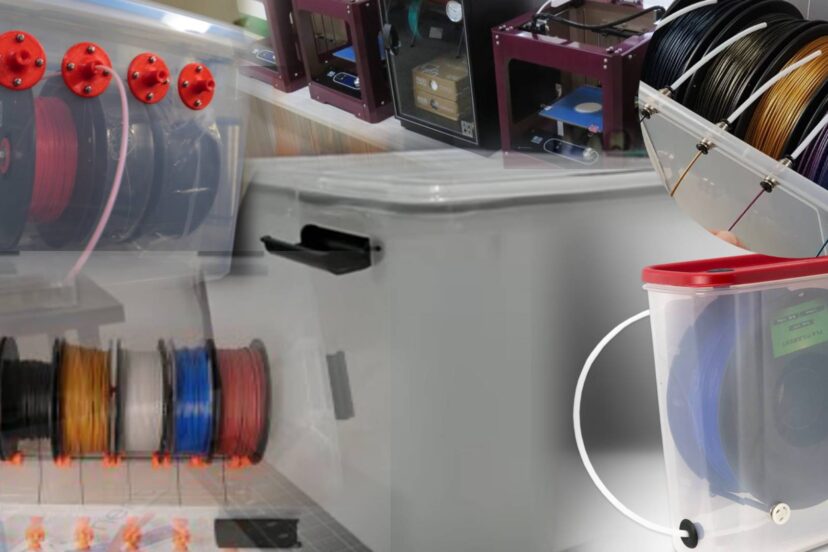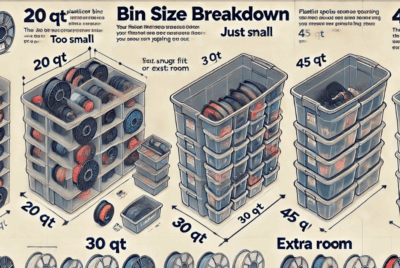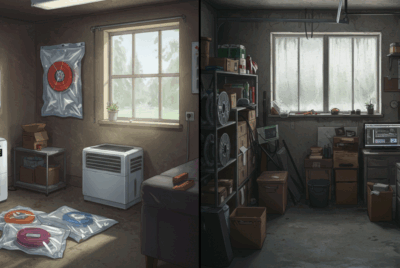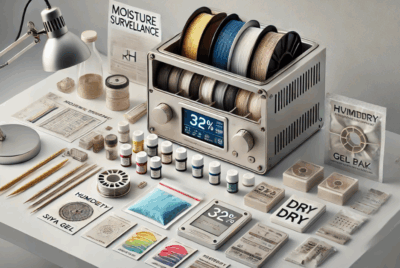3D Printing Filament Storage
In the rapidly evolving landscape of technology, 3D printing has emerged as a revolutionary force, reshaping industries from aerospace to healthcare, and from education to bespoke manufacturing. At the heart of this transformation lies the humble filament, the raw material that powers our 3D printers and brings our digital designs to life. The quality of this filament, however, is not just a matter of choice; it’s a cornerstone for innovation, precision, and reliability in 3D printing.
As an enthusiast and advisor deeply embedded in the realm of 3D printing, I’ve witnessed firsthand the critical role that filament storage plays in maintaining the integrity and performance of 3D prints. The journey from a spool of filament to a finished print is fraught with potential pitfalls, where environmental factors such as moisture, temperature, and light can degrade filament quality, leading to compromised print jobs.
In this article, we delve into the intricacies of proper filament storage, drawing upon a wealth of experience and research to offer insights and practical suggestions. Our aim is to empower you, the reader, with the knowledge to preserve the quality of your 3D printing filament, ensuring that each print meets your highest standards. Whether you’re a hobbyist working from your garage or a professional managing a fleet of printers, understanding and implementing effective storage solutions is essential for harnessing the full potential of 3D printing technology.
Importance of Proper Filament Storage to Maintain Quality
In the world of 3D printing, the filament is more than just a consumable. It is the building block of every project, where its quality is paramount to the success of each print. However, this quality is not static; it is continuously at risk from environmental factors that can significantly degrade its properties. Understanding the science behind filament degradation is essential for any 3D printing enthusiast or professional who seeks to maintain the highest standards of print quality.
The Science of Degradation: Moisture and Polymers
At the molecular level, filaments are susceptible to a process known as hydrolysis when exposed to moisture. This chemical reaction involves water molecules breaking down the polymer chains that make up the filament, leading to a loss of structural integrity. For materials like PLA, ABS, and Nylon, moisture can reduce the viscosity of the melted filament during printing, resulting in poor layer adhesion, inaccurate dimensions, and weakened printed structures.
Printable Life: An Essential Concept for Filament Care
The concept of “printable life” refers to the period during which a filament maintains its optimal properties for 3D printing. This timeframe is significantly influenced by storage conditions. Without proper care, the printable life of a filament can be shortened, leading to increased material waste and the need for more frequent replacements.
The Impact of Humidity and Temperature
Humidity is the primary culprit in filament degradation, but temperature also plays a critical role. High temperatures can accelerate the hydrolysis process, while fluctuations can cause condensation, further exposing the filament to moisture. Thus, controlling both temperature and humidity is crucial for extending the printable life of your materials.
Protection Against Dust and UV Light
Dust particles can not only contaminate the filament but also cause physical damage to the printer’s extruder and hotend, leading to clogs and print failures. Similarly, exposure to UV light can weaken the filament through photodegradation, altering its color and mechanical properties. Proper storage solutions must, therefore, shield the filament from these environmental threats as well.
- Various filament storage containers and solutions are available in the market, catering to different budgets and filament storage needs.
- Resealable bags are a cost-effective option for short-term storage, while dry boxes offer enhanced protection and moisture control.
- Filament-specific enclosures, such as filament dryers, provide advanced features like precise temperature and humidity control.
When selecting a storage solution, it’s crucial to consider the type and quantity of filament you have, as well as your printing requirements. Investing in the right storage containers will not only protect your filament from moisture but also allow for easy access and organization of different filament types.
Evaluating Filament Moisture Levels and Drying Techniques
To ensure that your filament is in optimal condition for printing, it’s essential to evaluate its moisture levels. A hygrometer can be used to measure the humidity inside the filament storage area. Additionally, performing a simple test print can reveal signs of moisture absorption, such as bubbling or hissing sounds during extrusion.
Advanced Moisture Control and Protection Strategies
While maintaining a stable environment is foundational for filament storage, advancing beyond basic practices can significantly enhance filament longevity and performance. Here, we explore sophisticated strategies for moisture control and protection, integrating technology and sustainability into your 3D printing workflow.
Smart Environmental Monitoring
In the era of smart technology, leveraging IoT (Internet of Things) devices for environmental monitoring offers a proactive approach to filament storage. Smart sensors can track temperature and humidity levels in real-time, sending alerts to your mobile device or computer when conditions deviate from the set optimal range. This enables immediate adjustments, ensuring your filament is stored under ideal conditions without the need for constant manual checks.
Renewable Desiccants: A Sustainable Choice
Traditional silica gel packs are effective at absorbing moisture but often end up in landfills after their absorption capacity is reached. Renewable desiccants, such as silica gel packs that change color when saturated and can be regenerated in an oven, offer a more sustainable and cost-effective solution. This not only reduces waste but also ensures that your storage containers always have active moisture control.
Advanced Filament Storage Solutions
Beyond basic airtight containers, the market now offers advanced filament storage solutions designed to actively regulate the environment:
- Vacuum-Sealed Containers with Hygrometer Inserts: These containers allow for a near-total elimination of air, significantly reducing the risk of moisture affecting the filament. Built-in hygrometers provide a visual indication of the internal humidity levels, making it easy to monitor the effectiveness of your storage solution.
- Thermoelectric Cooling Dry Boxes: For those in extremely humid climates, thermoelectric cooling dry boxes offer an advanced level of protection. By actively cooling the air inside the box, these units can maintain a consistent low-humidity environment, ideal for sensitive filaments like Nylon and PVA.
- UV-Resistant Materials: Ensuring that storage solutions are made from UV-resistant materials adds an extra layer of protection against photodegradation, preserving the mechanical properties and color of your filament.
Implementing a Layered Storage Strategy
A layered storage strategy involves using multiple levels of protection to safeguard your filament. Start with renewable desiccants in vacuum-sealed containers, place these containers in a cool, dark place, and monitor the environment with smart sensors. This comprehensive approach addresses all aspects of filament degradation, offering the best defense against moisture, temperature fluctuations, and UV exposure.
In-depth Analysis of Filament Storage Containers and Solutions
The market for filament storage solutions is diverse, offering options for every level of need and budget. From simple resealable bags to sophisticated filament dryers, choosing the right storage solution can make a significant difference in the quality of your 3D prints. Here, we compare various storage solutions, highlighting their benefits and considerations.
Resealable Bags: Simple and Cost-Effective
Resealable bags, often coupled with desiccant packs, provide a basic level of protection against moisture. They are ideal for short-term storage or for filaments that are used frequently.
- Pros: Cost-effective, easy to use, and transparent for easy identification of filament type and color.
- Cons: Limited protection against UV light and physical damage. Not the most durable solution for long-term storage.
Vacuum-Sealed Containers with Humidity Indicators
These containers offer an enhanced level of protection by removing air from the storage environment, significantly reducing the risk of moisture absorption.
- Pros: Effective moisture control, reusable, and often come with built-in humidity indicators to monitor the storage environment.
- Cons: More expensive than resealable bags and require a vacuum pump or machine for sealing.
Dry Boxes: Enhanced Protection and Moisture Control
Dry boxes are designed specifically for filament storage, with features like airtight seals and desiccant compartments. Some models also offer thermoelectric cooling for added humidity control.
- Pros: Excellent moisture control, protect against dust and UV light, and can feed filament directly to the printer, reducing exposure to ambient air.
- Cons: Higher cost and larger physical footprint compared to bags or containers.
Filament-Specific Enclosures: Filament Dryers
Filament dryers go a step beyond storage, actively drying filament over extended periods. They are ideal for filaments that are particularly hygroscopic, such as Nylon or PVA.
- Pros: Precise temperature and humidity control, improve print quality by drying filament before use.
- Cons: Most expensive option, requires electricity, and may be overkill for less sensitive materials.
Comparative Analysis: Making the Right Choice
When selecting a filament storage solution, consider the following factors:
- Type of Filament: More sensitive materials may require advanced solutions like dry boxes or filament dryers.
- Volume of Filament: Large quantities of filament may benefit from scalable solutions like dry boxes that can accommodate multiple spools.
- Frequency of Use: Frequently used filaments might be best stored in easily accessible dry boxes, while less commonly used materials can be vacuum-sealed for long-term storage.
- Budget and Space: Balance the cost of storage solutions against the value of the filament and the space available in your workspace.
Comprehensive Guide to Evaluating Filament Moisture Levels and Drying Techniques
Maintaining the right moisture level in your 3D printing filament is crucial for achieving high-quality prints. Over time, filaments can absorb moisture from the air, leading to print defects and poor performance. Here, we explore methods for evaluating filament moisture levels and outline effective drying techniques.
Assessing Filament Moisture Levels
Before deciding on the need for drying your filament, it’s essential to assess its moisture level accurately. This can be done through several methods:
- Visual Inspection and Print Testing: Look for signs of moisture such as stringing, bubbling, or steam during printing, which indicate high moisture content.
- Using a Hygrometer: Measure the humidity level inside your filament storage container. High humidity levels suggest that your filament may be exposed to moisture.
- Weight-Based Tests: Weigh your filament before and after drying. A significant reduction in weight indicates moisture loss.
- Moisture Analyzers: For a more precise measurement, use a moisture analyzer designed for plastics. This method provides an exact moisture content percentage, ideal for sensitive materials.
Drying Techniques for Filament
Once you’ve determined that your filament contains excessive moisture, the next step is to dry it. Here are the most effective methods:
- Food Dehydrator: A popular, cost-effective solution that circulates warm, dry air around the filament. It’s gentle enough to prevent thermal degradation while effectively removing moisture.
- Filament Dryer: Dedicated filament dryers offer precise temperature control and can dry spools over extended periods. They are ideal for materials that are extremely sensitive to moisture.
- Oven Drying: For a DIY solution, a conventional oven can be used. However, this requires careful temperature monitoring to avoid melting or deforming the filament. Use the lowest possible setting (usually below 70°C for most materials) and dry for 4-6 hours, depending on the filament type.
- Sun Drying: While not as effective, placing filament in a sealed container with desiccants under the sun can marginally reduce moisture content. This method is only recommended as a last resort.
Optimizing Drying Times and Temperatures
Different materials require specific drying temperatures and times. Here’s a quick guide:
- PLA: 40-45°C for 4 hours
- ABS: 80°C for 2-4 hours
- Nylon: 70-80°C for 6-12 hours
- PETG: 65°C for 4 hours
Always refer to the filament manufacturer’s guidelines for the best results, as some specialty filaments may have unique requirements.
Maintaining Filament After Drying
After drying, immediately store the filament in airtight containers with desiccants to prevent re-absorption of moisture. For long-term storage, consider vacuum-sealing with a moisture indicator to monitor the filament’s condition.
DIY Filament Storage Options and Hacks
For the 3D printing enthusiast looking for personalized and cost-effective filament storage solutions, the DIY route offers endless possibilities. By leveraging simple materials and a bit of ingenuity, you can create an environment that keeps your filament dry, organized, and ready for printing. Here are some innovative DIY filament storage solutions and hacks:
Airtight Containers with DIY Silica Gel Packs
Transform standard airtight containers into filament storage solutions by adding DIY silica gel packs. Silica gel can be purchased in bulk and packaged in breathable fabric to create reusable desiccant packs. These containers can be further customized with 3D-printed spool holders and humidity indicators, providing a simple yet effective storage system.
Repurposed Cabinets with Climate Control
An old cabinet or wardrobe can be repurposed into a large-scale filament storage system. By installing a dehumidifier and a small fan, you can create a controlled environment that protects filament from moisture. Additions like UV-blocking film on glass doors and multiple shelves allow for organized and protected storage of various filament types.
Custom Filament Dry Boxes
Using plastic storage boxes, small fans, and desiccant, you can construct custom dry boxes that not only store but actively dry your filament. Integrate hygrometers to monitor the interior environment and use 3D-printed pass-throughs to feed filament directly to your printer, minimizing exposure to ambient air.
IoT-Enabled Storage Monitoring
Elevate your DIY storage solutions by incorporating IoT devices. Small, inexpensive microcontrollers equipped with humidity and temperature sensors can provide real-time monitoring of your storage conditions. These devices can alert you via smartphone when adjustments are needed, ensuring your filament remains in optimal condition.
Vacuum Sealing with Hand Pumps
For long-term storage, vacuum-sealing filament spools can significantly extend their lifespan. Use hand-operated vacuum pumps and reusable vacuum bags designed for clothing storage as a budget-friendly alternative to electric vacuum sealers. Include a small packet of silica gel inside each bag for added moisture protection.
Benefits of DIY Filament Storage Solutions
- Cost-Effective: DIY solutions often utilize materials you may already have, reducing costs compared to commercial storage options.
- Customizable: Tailor your storage system to fit your specific needs, whether you’re accommodating a large collection of filaments or dealing with limited space.
- Innovative: DIY projects can lead to unique solutions that are not available on the market, providing both functionality and satisfaction from creating something useful.
Extending Filament Shelf Life Through Proper Storage Practices
The longevity of 3D printing filament is not merely about maintaining its current state but ensuring its performance does not degrade over time. By implementing a comprehensive storage strategy, it is possible to significantly extend the shelf life of your filament, preserving its quality for future printing projects. Here’s how:
Vacuum Packing with Oxygen Absorbers
One of the most effective methods for long-term storage of filament is vacuum packing. This process involves removing as much air as possible from the storage bag before sealing it, thereby minimizing the filament’s exposure to moisture and oxygen. Including oxygen absorbers in the vacuum bags takes this a step further by eliminating oxygen that could cause oxidation, further preserving the filament’s properties.
Advanced Desiccant Use
While silica gel is a common desiccant used in filament storage, exploring more advanced options can offer better moisture control. Indicating silica gel, which changes color when saturated, can provide visual alerts to the need for desiccant replacement or regeneration. For a more sustainable approach, consider using molecular sieves, which have a higher moisture absorption capacity and can be regenerated more times than silica gel.
Temperature and UV Light Control
Storing filament in a cool, dry place helps prevent the plastic from becoming brittle over time. Exposure to high temperatures can accelerate the degradation process, while UV light can cause discoloration and weaken the filament’s structural integrity. Utilizing storage containers made from UV-resistant materials or storing filament in locations that do not receive direct sunlight are simple yet effective ways to mitigate these risks.
Regular Moisture Level Checks
Even with the best storage solutions, it’s essential to periodically check the moisture levels of your filament. This can be done using a hygrometer placed inside the storage container or by conducting regular print tests to identify any signs of moisture absorption. Early detection allows for timely intervention, either through drying the filament or adjusting storage conditions.
Drying Filament Periodically
Incorporating a routine drying schedule for your filament can help maintain its quality, especially for materials prone to moisture absorption like Nylon and PVA. Using a filament dryer or a food dehydrator at recommended temperatures for a few hours can rejuvenate filament, restoring its printability without causing thermal degradation.
Custom Storage Solutions
For enthusiasts with a large collection of filament types, custom storage solutions that cater to the specific needs of different materials can be beneficial. This might include separate containers with tailored humidity control for hygroscopic filaments or dedicated dry boxes for quick-access materials.
The Value of Investment in Proper Storage
In the dynamic world of 3D printing, where innovation and precision are paramount, the importance of filament storage cannot be overstated. Proper storage practices serve as the foundation for high-quality prints, ensuring that the filament, the very lifeblood of 3D printing, remains in optimal condition. As we have explored, investing in suitable storage solutions not only preserves the integrity of the filament but also extends its usable life, offering significant long-term benefits.
Maximizing Print Quality and Consistency
The direct correlation between filament quality and print outcomes is undeniable. By protecting filament from moisture, dust, and UV light, and by maintaining it in a controlled environment, you ensure that each print reflects your expectations and meets the standards of precision and reliability that 3D printing promises. This investment in proper storage is an investment in the consistency and excellence of your printing projects.
Reducing Waste and Saving Costs
Effective storage solutions mitigate the risks of filament degradation, reducing the need for frequent replacements and minimizing wasted materials. This not only has a positive impact on the environment by lessening plastic waste but also translates into cost savings over time. The initial investment in proper storage solutions pays dividends by preserving your filament stock, allowing you to utilize every spool to its full potential.
Enhancing the 3D Printing Experience
A well-organized and efficiently managed filament storage system enhances your overall 3D printing experience. It offers peace of mind, knowing that your materials are protected and ready for use at a moment’s notice. This reliability and efficiency streamline the printing process, making it more enjoyable and productive.
Conclusion
The journey of a 3D printing project from concept to completion is intricate and filled with variables. Among these, the quality of the filament stands out as a critical factor in determining success. By recognizing the value of proper filament storage, you take a crucial step towards mastering the art and science of 3D printing. Remember, the investment in proper storage practices is not just about preserving filament; it’s about empowering your creativity, ensuring that every print, from the first layer to the last, captures the full potential of your vision.
Investing in the right storage solutions is a testament to your commitment to quality, sustainability, and excellence in 3D printing. Let us embrace these practices, not as mere recommendations, but as essential components of our 3D printing journey.
FAQs
- What happens if I don’t store my filament properly?
If you don’t store your filament properly, it can absorb moisture from the ambient environment, resulting in print quality issues such as poor adhesion, rough surfaces, and clogged extruders. Additionally, exposure to dust and UV light can degrade filament quality over time. - Can I reuse filament that has absorbed moisture?
Filament that has absorbed moisture can be dried using appropriate techniques, such as using a dedicated filament dryer or an oven with controlled temperature settings. However, it is important to note that repeated exposure to moisture can affect filament quality, so it’s best to prevent moisture absorption in the first place. - How often should I check the moisture levels in my filament?
It is a good practice to periodically check the moisture levels in your filament, especially if you live in a humid environment. Checking moisture levels before each print or every few weeks is recommended to ensure optimal print results. - Can I store different types of filament together in the same container?
Storing different types of filament together in the same container is generally not recommended. Different filaments may have different storage requirements, and storing them together can lead to cross-contamination or moisture transfer. It is best to store each type of filament separately in dedicated containers or compartments. - Are there any specific considerations for long-term filament storage?
For long-term storage, it is crucial to ensure that filament is protected from moisture, dust, and UV light. Consider using airtight containers with desiccants and storing them in a cool, dry place away from direct sunlight. Regularly checking the moisture levels and periodically drying the filament can help maintain its quality during long periods of storage.




